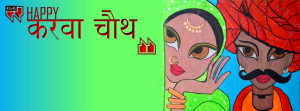This painting represents the final phase of the Karwa Chauth ritual, a festival of married Hindu women, extremely popular in India, involving primarily a daylong fast, which they observe for their husbands’ long life and prosperity. The fast accomplishes after the moon rises and the women on fast behold it and make offerings.
As is obvious, Karwa Chauth, the festival name, combines two terms, ‘karwa’, that is, a pot with spout, initially earthen but now more often cast of sugar, and ‘chautha’, the fourth day, that is, the fourth day of one of the months to which ‘karwa’ imparts distinction of a festival. This specific ‘chautha’ falls in the first half, that is, the dark half, of the month of Kartika, broadly the period around mid-October. Those observing Karwa Chauth related austerities would rise early in the morning when it is still dark, bathe and take some light food and keep the fast for the rest of day. The day is a normal one except that they spent some time in collecting ritual articles, especially the ‘karwa’, which they will decorate with variously coloured paste of rice and will worship Shiva and Parvati, the model of ideal happy family.
 Kids Portal For Parents India Kids Network
Kids Portal For Parents India Kids Network







